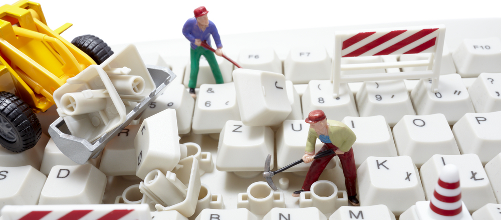Blog posts tagged PC
The best ways to upgrade your PC on any budget
 Lethargic laptop? Dodgy desktop? If your computer's starting to feel long in the tooth, that doesn't mean you have to consign it to the scrap heap just yet.
Lethargic laptop? Dodgy desktop? If your computer's starting to feel long in the tooth, that doesn't mean you have to consign it to the scrap heap just yet.
You can boost your computer's performance on almost any budget. So here are upgrades to fit four price ranges, starting at a cost of £0.
Upgrade budget: £0
Well, this is tricky. How do you improve the performance of an ageing computer without spending a penny?
For modest performance gains, go and grab a copy of CCleaner and run it on your computer over lunch. It'll free up disk space, shut down unnecessary programs that run at startup and generally speed things up a bit.
If you're feeling more adventurous, you could ditch Microsoft Windows in favour of an operating system that doesn't demand so much from your poor old computer. The obvious option is Linux. There's lots of choice, but Ubuntu and Mint are both popular. However, they can be intimidating if you've never stepped outside Windows before.
Having said that, some versions of Linux can be as demanding as Windows, and Microsoft has worked hard to make recent versions of Windows more efficient. Proceed with caution, then. A good option is to try running Linux from a CD, so you don't make any permanent changes to your computer.
Upgrade budget: £30 - £50
There's one really obvious candidate in this price range: extra memory for your computer. Boosting the amount of RAM (random access memory) your PC has is usually the single most effective way to increase its performance without spending hundreds.
For instance, if you'd bought a Dell Inspiron 1520 laptop back in 2010, it might have come with 1GB (gigabyte) of RAM. It costs just £34.99 + VAT to quadruple this - and while its performance isn't going to quadruple too, things will certainly feel a lot snappier.
Crucial make and sell RAM, and their website has a good tool to help you find the right memory for your computer. You can also buy it from eBuyer, dabs.com and PC World Business.
Installing extra RAM is usually pretty easy, even if you've never delved inside a computer before. Here are video guides for laptops and desktops.
Upgrade budget: £100
How you choose to spend £100 will depend on how you use your computer and what sort of computer you have.
If your computer's a year or two old and still feels adequate for work, you might want to simply buy a bigger monitor or add a second screen. Having more space to work in can boost your productivity impressively.
Decent, affordable screens include the Benq GW2250HM (£116), the ViewSonic VX2336 (£110) and the Hanns.G HL229DPB (a bargain £73).
Alternatively, you can add an extra hard drive or replace your existing drive. Here you have a couple of options:
- If you're tight for storage space, plump for a high-capacity hard drive. This 3TB (terabyte) model (£103) is designed for desktop computers and will have more space than you're likely to use. For laptops, this 1TB drive (£77) could be a good option.
- For a big speed boost in a laptop, swap your hard drive for a solid state drive (SSD). At this budget you'll have to make do with less space for files, but as an SSD accesses data many times faster than traditional hard drives, performance gains can be impressive. Pick up these Samsung or Crucial drives for around £80.
Upgrade budget: £200 - £300
Now we're into serious money. At this level, think long and hard about whether your money should be spend on an upgrade or put towards a new computer. Less than £400 can get you a capable desktop computer, like this Dell Vostro.
How to decide whether to upgrade >>
If you decide to upgrade and have a desktop PC, your budget should cover an entirely new motherboard and CPU.
Replacing these items can make a huge difference to performance. The motherboard is your computer's main circuit board, so replacing it should remove any bottlenecks. The CPU (central processing unit) is your computer's brains, so if you swap it you'll see the performance jump - as long as the other components are up to it.
You'll need to do some research to determine the best motherboard and CPU to upgrade to. Speak to your IT support company or computer manufacturer if you're unsure. Companies like Misco, eBuyer, Dabs and Amazon sell motherboards and CPUs.
If you're not ready to rip out the guts of your computer, or you own a laptop (replacing a laptop motherboard is near-impossible!), take another look at solid state drives. At this sort of price you can get a large SSD for your laptop, meaning you'll be able to see significant performance benefits without compromising on storage space so much.
If you're willing to spend around £300, you should be able to get a 500GB SSD, like this model from Crucial or this Samsung drive.
Have you upgraded your computer recently? Let us know how it went in the comments.
- Should you upgrade or buy new?
- Learn about solid state drives (SSDs) and how they boost performance
- Cope with increasing data storage needs
(Speedometer image: Flickr user Nathan E Photography.)
Why you’ll never buy another PC again

I run a small IT company and I make no apologies for making my customers keep their hardware up to date. I feel it makes a real difference to the productivity of their staff. Modern, reliable, stable hardware returns investment many times over. It’s all about keeping your staff able to do their jobs and not waiting around to get problems fixed.
About five years ago we took on a client with about 40 computers. It soon became apparent that their hardware was flagging and that their computers would need to be replaced.
We put together a replacement schedule and upgraded a couple of machines each month to make sure we didn’t blow the IT budget. As a smaller business this worked for our client, and gradually things improved.
Upgrade time again!
Productivity improved and their people started to think differently about IT. But, of course, several years later we we’re about to run into the same marathon again. The customer wanted to upgrade to Microsoft Office 2010 and their new line of business application required a little more memory than the standard 2GB that most of their computers had.
Upgrade time again! The trouble was that this time we needed everyone to get up to speed quickly to fall in line with the new application. That worked out at a cost of about £10,000 for new computers.
Obviously we didn’t want to spend all that cash but knew that in order to maximise the investment in software we would need to do something. Up steps thin client computing.
What is thin client computing?
Thin client computing means your software and applications are run on a server. Your PC only handles the screen, keyboard and mouse movements. Most of the computing power is centralised. In other words, the server does all the hard work so the client PC doesn’t need to be upgraded.
There are lots of business advantages to thin client computing:
- People can connect to the system and use their software from anywhere, as long as they have internet access.
- We only need to maintain one copy of the software for everyone as it’s essentially installed once on the server.
- It’s fast and scalable, because you only have to upgrade the server, not individual PCs.
- It costs less. For the client I’m dealing with at the moment, using thin clients will cost half what new computers would.
- It’s secure. The security is my personal favourite. Without thin clients you have users roaming around with laptops carrying the company’s data. But now - because everything’s done by the server - the laptop they use doesn’t hold any data.
So there you go. I see this as a win-win situation, and as a result I’m sure there will be a big push towards thin client computing over the next five years. In fact, Dell is so confident about this that at the start of this month they announced they had acquired Wyse, a PC manufacturer which specialises in thin client terminals.
Thin client is the perfect accompaniment to cloud computing. It’s a technology that has been around for years. However, the next two years are when it’ll really shine.
Lee Wrall is founder and MD of Everything Tech, an IT support and service provider based in Manchester



